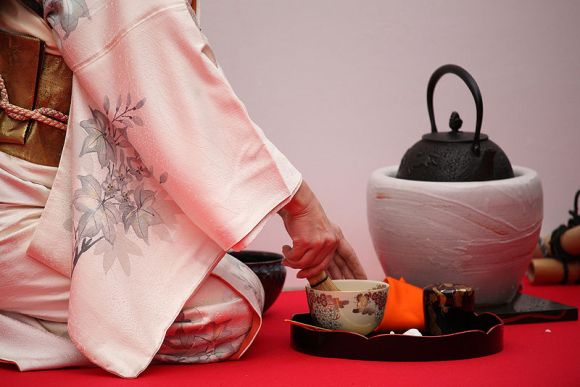
The culture of tea in Japan goes back one thousand years. Today, we’re going to scratch the surface with this short introduction to the wonders of the Japanese tea ceremony.
In the U.K. they serve high tea. In Australia, they serve morning tea and afternoon tea. In Japan, they have chado, literally “the Way of Tea.” In the U.S., in contrast to the Way of Tea, we had the Bay of Tea, dumping vast quantities of it into the harbor to protest England’s tax on tea. You haven’t been able to get a good cuppa in the U.S. since.
▼ Tea Ceremony in Japan
▼A tea party in America in 1773.

But Japan tops us all when it comes to tea and tea parties. Japanese tea ceremony is an art form that has been perfected over a thousand years. Japanese tea masters dedicate their lives to the ritual preparation of a simple bowl of tea.
In Japan the tea ceremony can be a half-day affair, lasting up to four hours—if you’re prone to spending long periods of time at the library without actually reading any books, this may be just the activity for you! Indeed, there are literally thousands of books on the Japanese ritual of tea, none of which you will probably ever read.
Origins of Chanoyu
The tea ceremony, (called chanoyu, or chado if you prefer, or even sado if you insist) was brought to Japan from China along with myriad other Chinese culture that was crammed onto a cargo boat. It’s incredible when you think about all the stuff the Japanese brought back with them from China: kanji, calligraphy and the tea ceremony being just a paltry few. I imagine Japanese Buddhist priests such as Eichu and Kukai (after having imported Buddhism) walking through the vast country of China and pointing to various things: “We’ll have some of that Shingon Buddhism, and a bit of the Bodhidarma, and by the way, give us some of that tea ceremony with a bit of calligraphy on the side!” Only after the tiny boat was full did they claim, “Anchors away!” and bring all their plunder here to Japan. In fact, Japan was the world’s first China Town. But since there were hardly any Chinese people in this country, they just called it Japan.
Even the “Seven Lucky Gods” came to Japan from China. They managed to all fit on a tiny vessel called the takarabune, destined for the 800-km journey which we presume terminated at the port of Nagasaki.
▼ The takarabune treasure boat carrying the Seven Lucky Gods, proves that a lot of Chinese culture could be loaded onto just one small boat.
The Japanese tea ceremony eventually developed into its own version, a four-hour event of absolute propriety, performed while wearing a traditional kimono and kneeling seiza style. You see, this is not your grandmother’s cup of tea (unless your grandmother is Japanese, in which she probably used the tea ceremony as a form of strict childhood discipline). It’s impressive that the interminable ceremony has endured to this day, despite this proclaimed age of instant gratification. There is not even a tea ceremony app.
But luckily, we now have a shorter Way of Tea. The abbreviated version came about, no doubt, because just having a cup of tea in the morning was enough to prevent people from getting to work before noon. So, just like the game of cricket, which used to play week-long tournaments but had to shorten the game in order to retain its fan base (sometimes people died before the end of a tournament), the tea ceremony now has a more casual and endurable version for those who don’t want to risk losing their lower limbs by sitting for long periods of time seiza style.
▼Japanese powdered green tea is called matcha.
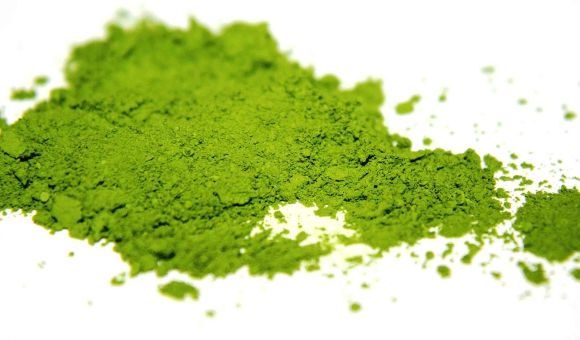
These shorter tea ceremonies, called chakai, are a good introduction into the world of matcha, Japanese powdered green tea. If after this abridged version, your legs have survived the pins and needles and are still very much attached to the body, then by all means, try to sever them completely in the four-hour rendition. Try to go for one that includes a high-class kaiseki ryori meal. Good food is known to make leg pain more endurable.
Tea Houses
Japanese tea houses historically populated the archipelago along pilgrimage routes such as the Tokaido, Basho’s Narrow Road to the Deep North and the Kumano Kodo where travelers would stop to rest and have a cuppa.
▼ “The morning after a snowfall” by Katsushika Hokusai shows the tea house at Koishikawa from Thirty-six views of Mount Fuji.
▼ The (reconstructed) remains of the “Sakurachaya” tea house along the Kumano Kodo. The owners of the tea house would look out to the other side of the valley for pilgrims coming over the mountain then start preparing tea and mochi for their arrival.
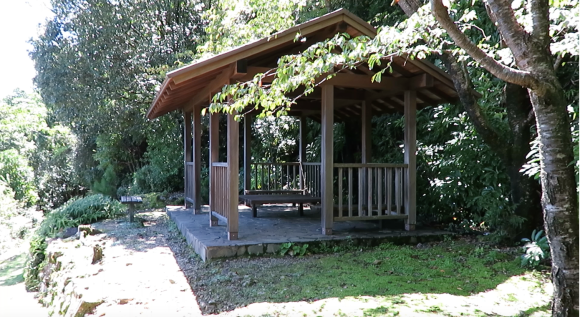
Needless to say, with the modern-day pit stops such as Starbucks, the experience of stopping for a cup of tea along the road has changed quite a bit.
Let’s look at exactly what is involved in Japanese tea ceremony. In an overt act to discipline the masses, the tea ceremony reminds us to be mindful of others, appreciative of nature, and to put our hosts above everything else. Silence and quiet talking are valued (no gossiping or complaining about work), as well as appreciation of the intricate tools used, the proscribed ceremony procedures and the value of sharing a cup of thick green liquid among friends.
Private Tea Houses
You’ll need a tea house or at least a special tea room to take part in a tea ceremony (although some are performed outside). Many of Japan’s famous gardens (the ones you have to pay to get into) have traditional Japanese tea houses and they will offer tea ceremony experiences on certain days of the year.
▼ Japanese tea houses are usually made of natural materials on order to appreciate the blessings of nature.
Inside the tea house
The tea room will contain a tokonoma in which will to display a calligraphy scroll and a flower arrangement. This one also displays an incense burner. The floor is traditional tatami mats which can be knelt on for the event.
Tools for making tea
There are many special tools (hundreds, actually) for making Japanese tea but here are some of the basics: A lacquered storage container for holding the green tea powder, ceramic tea bowls, and a bamboo whisk. Ceramics are specially selected according to their personality and aesthetics.
▼ Pictured: Not a gantleman’s shaving kit
▼ Chaki, storage container for powdered matcha tea.
Tea Master
Of course, a tea ceremony cannot be held without a host. True tea masters dedicate their lives to perfecting each aspect of the tea ceremony, imbuing it with meaning and purpose. Monks are often trained in the art, and many of Japan’s most famous tea masters have been Buddhist monks. So you can rest easy that no matter what may happen in the world, there will be one monk who will calmly call everyone together for a sober bowl of tea before panicking.
One of Japan’s famous tea masters and Zen priests, Ikkyu Sojun (1394-1481) imbuing meaning and purpose.

The most recent tea ceremony I attended was surely one that would make the Guinness Book of World Records for most ephemeral tea ceremony in Japan. I attended the spring Miyako Odori geisha show in Kyoto. This traditional performance included a tea ceremony with a maiko (apprentice geisha) before the show. Wow, count me in!
▼A maiko prepares for a tea ceremony in Gion, Kyoto.
When I arrived at the theater in Gion, I entered the waiting room with one hundred other people, all Japanese. The lady sitting next to me told me she lived in Kyoto and came to the spring show every year. I felt lucky to be taking part in something so Japanese, something not merely put on for foreign tourists.
Once we were let into the tea ceremony room, which was big enough to hold ballroom dances, we were directed to long low tables with zabuton cushions next to them to kneel on, the faithful filing into each rank as if being ushered into rows of church pews. Each place setting had a Japanese sweet. Women in kimono hurried around filling tea bowls.
▼Japanese sweets are served to balance the bitterness of the green tea.
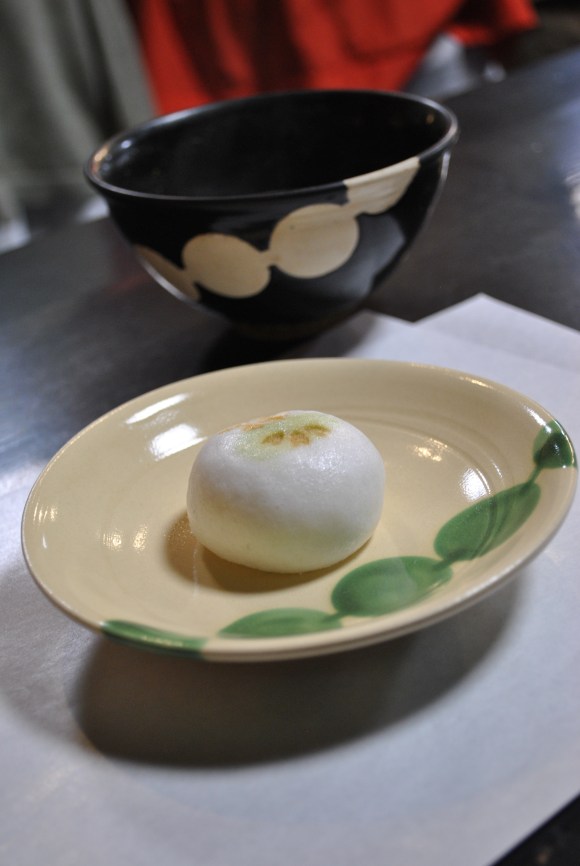
I took a few photos of the green sweets and the tea…
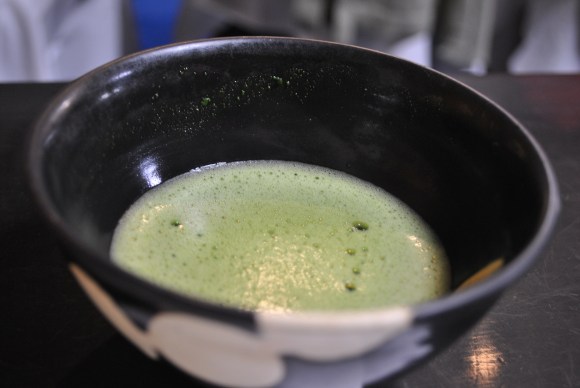
…and when I looked up, the entire room had already finished their tea and was being herded into the performance hall. I was shocked to experience a five-minute tea ceremony. That was one whirlwind appreciation of nature, serenity and spiritual depth!
I was expecting more of something out of Matsuo Basho haiku:
A monk sips morning tea,
it’s quiet,
the chrysanthemum is flowering.
But all I heard was the clanking of tea bowls being cleared. When I stood to get up, with no one standing or sitting in front of me now, for the first time I was able to see where the geiko (geisha) had, formerly, been making tea at the front of the room with the assistance of a maiko. But they had both already disappeared.
We were told to keep the plates the sweets had come on, probably to appease the organizer’s pangs of guilt. I felt sorry for these plates, made and painted for the sole purpose of a meaningful existence at a tea ceremony, where they would be admired and stroked, their colors complementing the season and their very character elevated to that of fine bone china. The harsh reality for these plates was that they had finished their purposeful life after just five minutes. They’ll probably never see a tea ceremony again.
It just goes to show that beauty is fleeting. And that a five-minute tea ceremony demands an app.

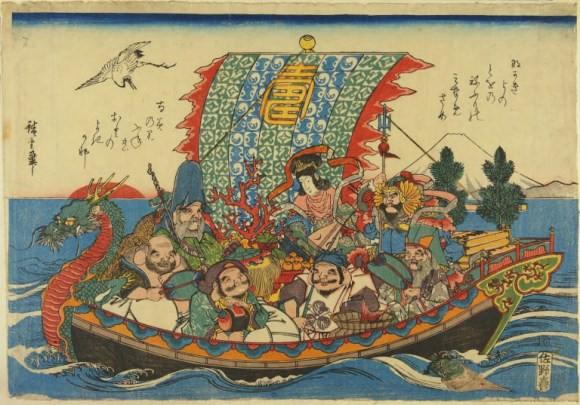
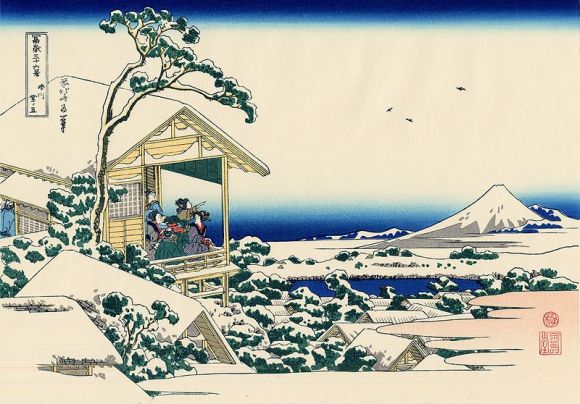
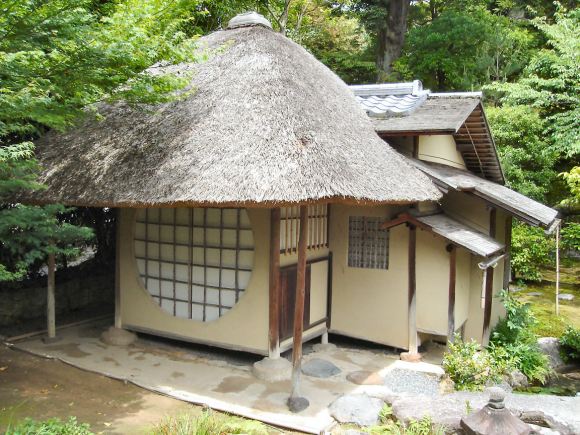
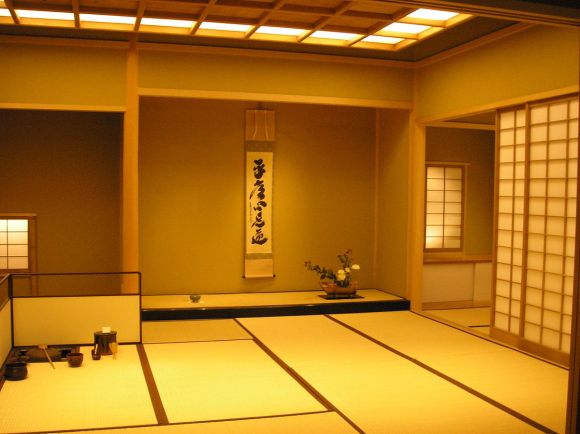
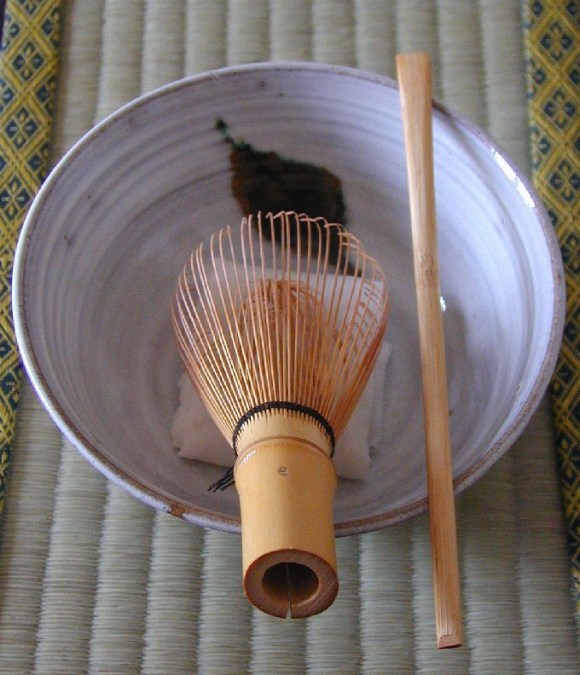
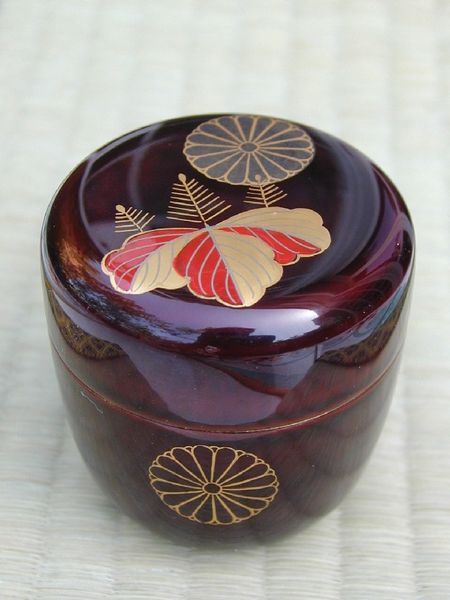
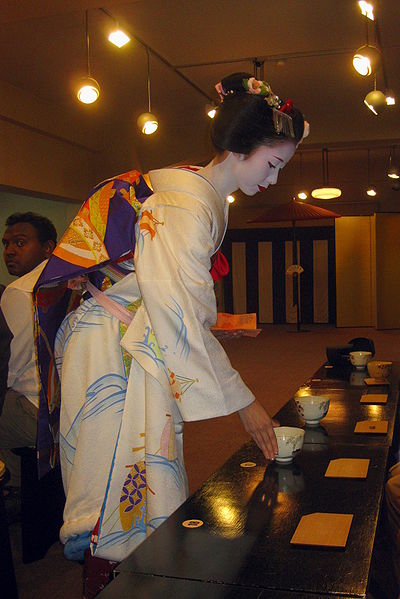
 Cyber Chakai aims to make Japan’s tea ceremony traditions more accessible with modern technology
Cyber Chakai aims to make Japan’s tea ceremony traditions more accessible with modern technology Robot performs traditional Japanese tea ceremony, serves up frothy matcha in seconds 【Video】
Robot performs traditional Japanese tea ceremony, serves up frothy matcha in seconds 【Video】 We spend a morning with an expert wagashi chef creating no-bake traditional Japanese sweets!
We spend a morning with an expert wagashi chef creating no-bake traditional Japanese sweets! Drink Green! We check out the amazing “Green Tea Party” presented by Isetan and Ito En! 【Pics】
Drink Green! We check out the amazing “Green Tea Party” presented by Isetan and Ito En! 【Pics】 Sharp’s Ocha-presso brings traditional Japanese flavor to your kitchen
Sharp’s Ocha-presso brings traditional Japanese flavor to your kitchen McDonald’s new Happy Meals offer up cute and practical Sanrio lifestyle goods
McDonald’s new Happy Meals offer up cute and practical Sanrio lifestyle goods All-you-can-drink Starbucks and amazing views part of Tokyo’s new 170 meter-high sky lounge
All-you-can-drink Starbucks and amazing views part of Tokyo’s new 170 meter-high sky lounge Studio Ghibli glasses cases let anime characters keep an eye on your spectacles
Studio Ghibli glasses cases let anime characters keep an eye on your spectacles More foreign tourists than ever before in history visited Japan last month
More foreign tourists than ever before in history visited Japan last month Starbucks reopens at Shibuya Scramble Crossing with new look and design concept
Starbucks reopens at Shibuya Scramble Crossing with new look and design concept Beautiful Sailor Moon manhole cover coasters being given out for free by Tokyo tourist center
Beautiful Sailor Moon manhole cover coasters being given out for free by Tokyo tourist center Hey, Japanese taxi driver! Take us to your favorite restaurant in Tsuruga City!
Hey, Japanese taxi driver! Take us to your favorite restaurant in Tsuruga City!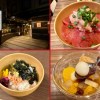 All-you-can-eat sashimi from Tokyo’s fish market, convenient location make this budget hotel great
All-you-can-eat sashimi from Tokyo’s fish market, convenient location make this budget hotel great Randomly running into a great sushi lunch like this is one of the best things about eating in Tokyo
Randomly running into a great sushi lunch like this is one of the best things about eating in Tokyo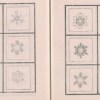 Beautiful, intricate drawings of snowflakes from Edo-era Japan
Beautiful, intricate drawings of snowflakes from Edo-era Japan Disney princesses get official manga makeovers for Manga Princess Cafe opening in Tokyo
Disney princesses get official manga makeovers for Manga Princess Cafe opening in Tokyo Beautiful new Final Fantasy T-shirt collection on the way from Uniqlo【Photos】
Beautiful new Final Fantasy T-shirt collection on the way from Uniqlo【Photos】 Is the new Shinkansen Train Desk ticket worth it?
Is the new Shinkansen Train Desk ticket worth it? Foreign English teachers in Japan pick their favorite Japanese-language phrases【Survey】
Foreign English teachers in Japan pick their favorite Japanese-language phrases【Survey】 Japanese convenience store packs a whole bento into an onigiri rice ball
Japanese convenience store packs a whole bento into an onigiri rice ball We try out “Chan Ramen”, an underground type of ramen popular in the ramen community
We try out “Chan Ramen”, an underground type of ramen popular in the ramen community Studio Ghibli releases Kiki’s Delivery Service chocolate cake pouches in Japan
Studio Ghibli releases Kiki’s Delivery Service chocolate cake pouches in Japan Japan’s bone-breaking and record-breaking roller coaster is permanently shutting down
Japan’s bone-breaking and record-breaking roller coaster is permanently shutting down New definition of “Japanese whiskey” goes into effect to prevent fakes from fooling overseas buyers
New definition of “Japanese whiskey” goes into effect to prevent fakes from fooling overseas buyers Our Japanese reporter visits Costco in the U.S., finds super American and very Japanese things
Our Japanese reporter visits Costco in the U.S., finds super American and very Japanese things Studio Ghibli unveils Mother’s Day gift set that captures the love in My Neighbour Totoro
Studio Ghibli unveils Mother’s Day gift set that captures the love in My Neighbour Totoro Foreign passenger shoves conductor on one of the last full runs for Japan’s Thunderbird train
Foreign passenger shoves conductor on one of the last full runs for Japan’s Thunderbird train Domino’s Japan now sells…pizza ears?
Domino’s Japan now sells…pizza ears? New Japanese KitKat flavour stars Sanrio characters, including Hello Kitty
New Japanese KitKat flavour stars Sanrio characters, including Hello Kitty Kyoto creates new for-tourist buses to address overtourism with higher prices, faster rides
Kyoto creates new for-tourist buses to address overtourism with higher prices, faster rides Sales of Japan’s most convenient train ticket/shopping payment cards suspended indefinitely
Sales of Japan’s most convenient train ticket/shopping payment cards suspended indefinitely Sold-out Studio Ghibli desktop humidifiers are back so Totoro can help you through the dry season
Sold-out Studio Ghibli desktop humidifiers are back so Totoro can help you through the dry season Japanese government to make first change to romanization spelling rules since the 1950s
Japanese government to make first change to romanization spelling rules since the 1950s Ghibli founders Toshio Suzuki and Hayao Miyazaki contribute to Japanese whisky Totoro label design
Ghibli founders Toshio Suzuki and Hayao Miyazaki contribute to Japanese whisky Totoro label design Doraemon found buried at sea as scene from 1993 anime becomes real life【Photos】
Doraemon found buried at sea as scene from 1993 anime becomes real life【Photos】 Tokyo’s most famous Starbucks is closed
Tokyo’s most famous Starbucks is closed One Piece characters’ nationalities revealed, but fans have mixed opinions
One Piece characters’ nationalities revealed, but fans have mixed opinions We asked a Uniqlo employee what four things we should buy and their suggestions didn’t disappoint
We asked a Uniqlo employee what four things we should buy and their suggestions didn’t disappoint Princesses, fruits, and blacksmiths: Study reveals the 30 most unusual family names in Japan
Princesses, fruits, and blacksmiths: Study reveals the 30 most unusual family names in Japan Häagen-Dazs Japan’s Yuzu Green Tea Float — How to make the super-easy matcha summer dessert drink
Häagen-Dazs Japan’s Yuzu Green Tea Float — How to make the super-easy matcha summer dessert drink Red Matcha: A new type of Japanese powdered tea years in the making
Red Matcha: A new type of Japanese powdered tea years in the making Our English writer rates 15 teas from Japanese conbini, is fully hydrated for the rest of summer
Our English writer rates 15 teas from Japanese conbini, is fully hydrated for the rest of summer New matcha Pocky from Japan is a heavenly treat for green tea lovers
New matcha Pocky from Japan is a heavenly treat for green tea lovers Stylish green tea “chablets” from Shizuoka are our new way favorite way to grab a cuppa
Stylish green tea “chablets” from Shizuoka are our new way favorite way to grab a cuppa Marine creature-themed tea bags transform teapots into aromatic oceans
Marine creature-themed tea bags transform teapots into aromatic oceans Shizuoka Prefecture may lose title of Japan’s top tea producer to rising star Kagoshima
Shizuoka Prefecture may lose title of Japan’s top tea producer to rising star Kagoshima Mister Donut demonstrates the wonders of hot bubble tea with royal milk and rich matcha flavors
Mister Donut demonstrates the wonders of hot bubble tea with royal milk and rich matcha flavors Experience afternoon tea with a Japanese twist in Harajuku!【Photos】
Experience afternoon tea with a Japanese twist in Harajuku!【Photos】 Oolong tea lattes get a place on the Starbucks Japan menu, but do they get one in our heart too?
Oolong tea lattes get a place on the Starbucks Japan menu, but do they get one in our heart too? We spill the tea–a guide to all of Japan’s Gogo no Kocha Milk Teas sold in the wintertime
We spill the tea–a guide to all of Japan’s Gogo no Kocha Milk Teas sold in the wintertime Nara University study finds some common teas can neutralize COVID-19
Nara University study finds some common teas can neutralize COVID-19 A Japanese tea house for inside your house? Tokyo company wants to offer micro chashitsu overseas
A Japanese tea house for inside your house? Tokyo company wants to offer micro chashitsu overseas Attack on Titan teas are selling out faster than a giant can eat a human
Attack on Titan teas are selling out faster than a giant can eat a human Still using water to make your instant noodles? You’re missing out on amazing green tea noodles!
Still using water to make your instant noodles? You’re missing out on amazing green tea noodles!
Leave a Reply